They say a photo’s the best way to capture a moment in time. But I tend to think of mason jars when it comes to keeping some of my favorite ones. Here is the moment: I’m rushing through a not-very-bustling strip of the Greenmarket in Carroll Gardens, adjacent to a park, and in the late afternoon. It’s not a market I go to often, but I’m making use of my chance location by picking up various things for various projects and affairs (padron peppers for a restaurant nearby, heirloom tomatoes for a Farmers Market Fix dinner kit), while keeping in mind that I’m traveling with these goods by bike. And then I chance upon a bright orchid eggplant in a crate, looking lonely, and even the farm attendant at the stand looks lonely, and we make eye contact for a moment, as I’m half-eyeing the eggplant. Yes, I’ll take that, too, I said, shoving the eggplant on the scale, on my harried way out. Remembering a conversation with a friend I had a few days ago about caponata.
True, you’re looking at a photograph of that eggplant, as caponata, in this blog, but naturally I hope you cherish a physical rendition of it in a mason jar in your own home soon. It is so incredibly memorable and good. Caponato is, as I’d described it to that friend before I could remember its name, sort of an Italian eggplant and tomato chutney. It’s a thick, chunky sauce of just-mushy eggplant cubes, smothered with tomatoes (preferably fresh and cooked down), with garlic, basil, and good olive oil. It could be tossed with pasta. But more typically, it’s something you dip bread into, because of its chunkiness and also its piquancy.
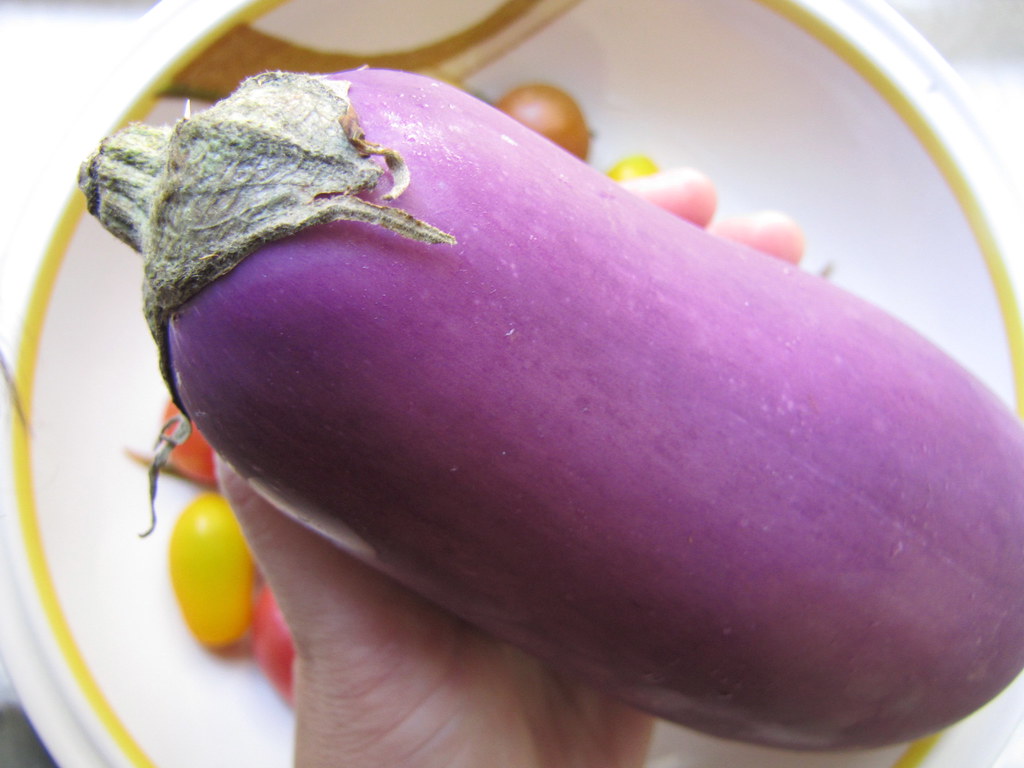 a “neon” eggplant from the Greenmarket
a “neon” eggplant from the Greenmarket
Caponata has more than a tinge of vinegar, traditionally. This makes it ideal for preserving, which it probably was intended for to begin with. It’s Sicilian in origin, but enjoyed throughout Italy nowadays, and elsewhere in Europe and the States. It often has onions or peppers cooked down until soft, and sometimes, capers, olives or seafood such as octopus enveloped into the sauce.

the firm eggplant is cubed
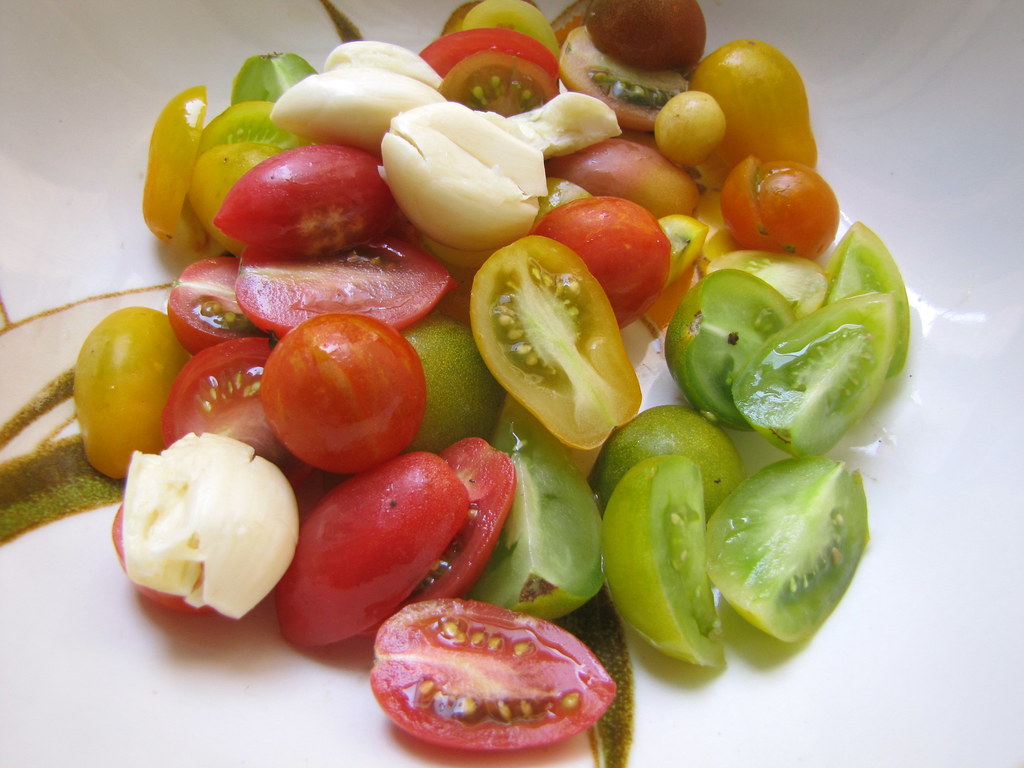 a pint of multi-colored grape tomatoes are halved
a pint of multi-colored grape tomatoes are halved
I went with a simple variation that marries eggplant with ripe, soft tomatoes and plenty of garlic and basil. This got a good touch of red wine vinegar for acidity (a must if you intend to preserve the sauce in a jar, as I did), and a squeeze of fresh lemon juice just before the lid was screwed on to further reduce the ph level of the sauce. I’ve jarred many pints of fresh tomato sauce over the summers before with a tablespoon of lemon juice as a rule of thumb to ensure the ph level stays safely low enough.
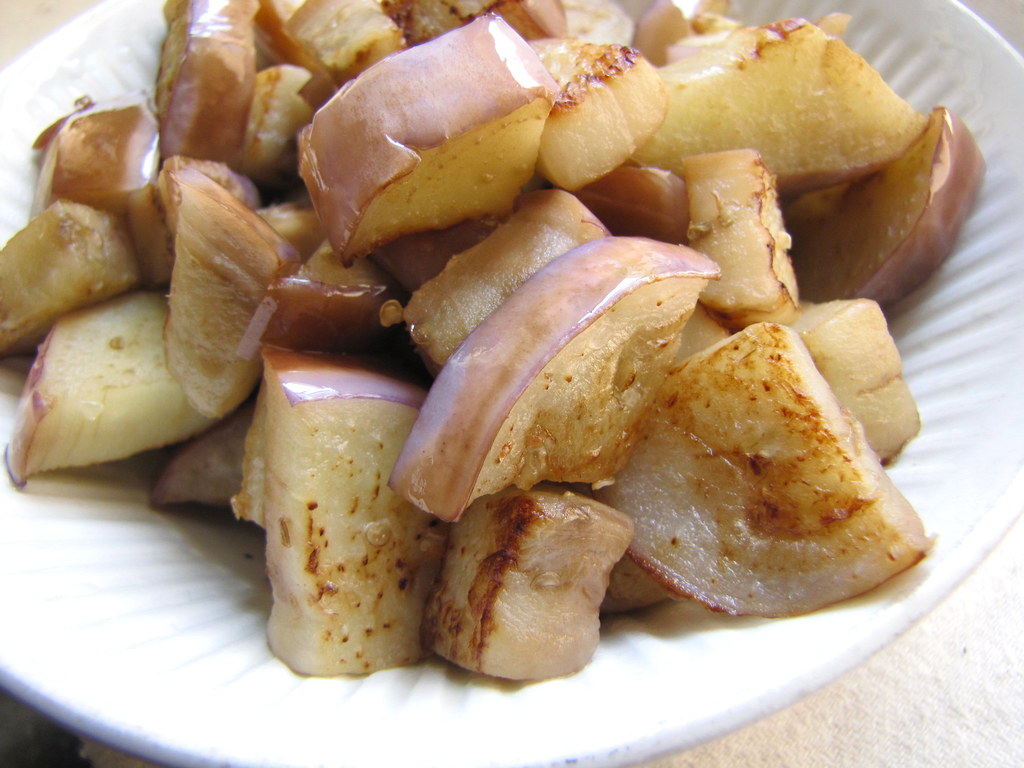 eggplant is cooked first until just browned and softened
eggplant is cooked first until just browned and softened
That’s really all you need to remember in order to make your caponata last all year long in a jar. That, and boiling your mason jar — even if it’s new — submerged in water to sanitize it. I was lucky to make slightly more of the summery dip than could fit in that jar, and enjoyed it spread on a sandwich with fresh mozzarella that day. The sharp flavor and velvety mouthfeel of this sauce is delectable. And one average-sized eggplant makes a perfect amount for these two portions — a small cup or so along with a pint to put up in a jar.
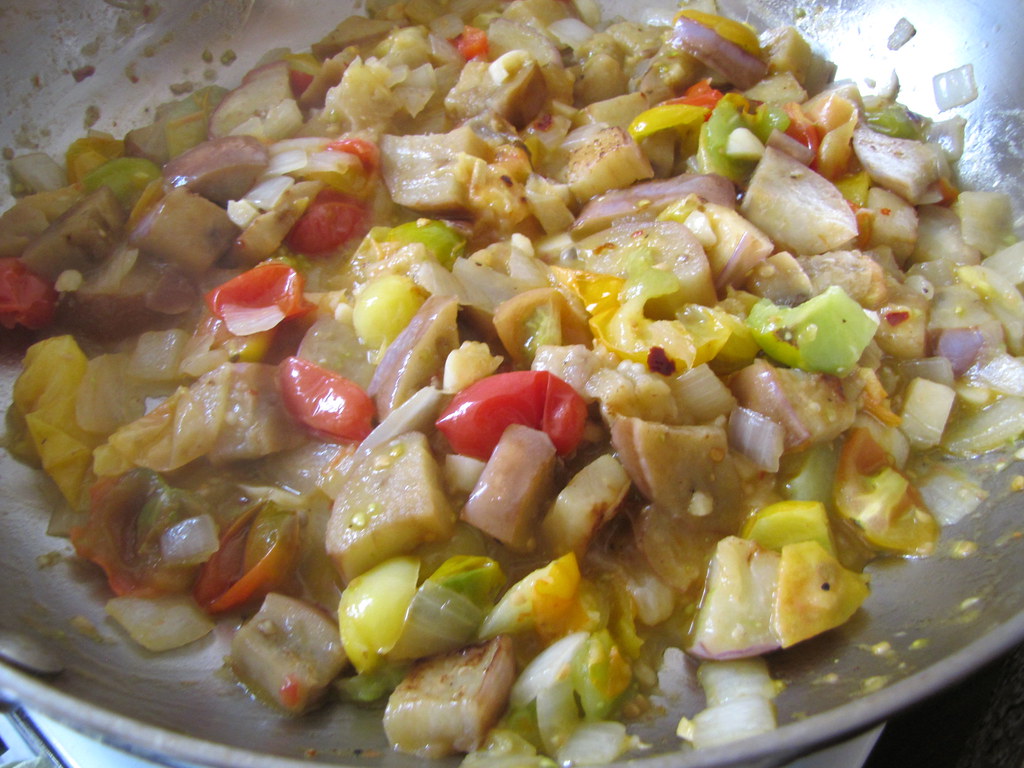 and returned to a pan of softening onions, garlic and tomatoes
and returned to a pan of softening onions, garlic and tomatoes
So here’s to more summery meals in the winter, thanks to that chance encounter with an eye-catching eggplant, and bountiful tomatoes of the season. Try adding additional herbs like thyme or tarragon to it if you like, or making it extra-spicy with fresh chilies or sweet and chunkier with corn. The recipes you can invent using it are likewise endless, too. And you will have plenty of time to think about those once the caponata is sealed for safekeeping.
Eggplant Caponata in a Jar
(makes 1 pint jar plus an extra cup for eating within a week kept in the refrigerator)
1 large eggplant, stem trimmed and cut to 1″ cubes
3-4 medium-sized tomatoes (or about 1 pint cherry or grape tomatoes), chopped
4 cloves garlic, minced
1/2 small onion, chopped
1/2 teaspoon red chili flakes (optional)
10-12 fresh basil leaves
1 tablespoon extra-virgin olive oil
2 teaspoons red wine vinegar
1 tablespoon fresh lemon juice
salt and pepper to taste
Place a pint-sized mason jar and its lid in a pot with enough water to submerge. Bring to a boil and let boil rapidly at least 5 minutes, completely submerged.
Heat the olive oil in a large, wide saucepan. Add the onions, optional chili flakes and eggplant cubes along with a couple pinches of salt and pepper. Cook over medium-high heat, stirring occasionally, until onions are opaque and eggplant pieces are slightly browned and are turning translucent brown rather than all opaque white, about 5 minutes. Add the tomatoes and garlic, and continue cooking another 2-3 minutes, or until tomatoes have released most of their juices and are squishy-looking. Add 1/2 cup of water and the vinegar. Let simmer, stirring occasionally, for another few minutes. Taste for seasoning, adding any additional salt or pepper. Add the fresh basil leaves.
Carefully remove the mason jar and its lid from its hot bath with tongs. Fill the mason jar just to an inch from its top with the caponata. Fill to just below the lid with the tablespoon of fresh lemon juice. Screw on the lid tightly. Place the jar standing upright back into the pot with hot water so that the water level reaches at least half the height of the jar. Boil the water with the jar standing upright inside the pot for another 5-10 minutes to “process” the jar. Remove the jar and let stand at room temperature to cool down. The jar’s lid will suck inward (often with a loud “pop”), sealing the jar after an hour or so of cooling, ensuring that it’s safe for storing at room temperature. Store jar away from sunlight (to preserve maximum flavor) for years. Refrigerate after opening. Refrigerate any un-jarred portion of the caponata for up to a week.
Cost Calculator
(for 1 pint plus 1 cup)
1 eggplant (at $3/lb): $2.25
1 pint cherry tomatoes: $3.00
1/2 onion: $0.25
4 cloves garlic: $0.20
1 tablespoon olive oil: $0.10
2 teaspoons red wine vinegar: $0.10
1 tablespoon fresh lemon juice: $0.15
12 fresh basil leaves (from houseplant): $0.25
salt, pepper, 1/2 teaspoon chili flakes: $0.05
Total (not including the jar!): $6.35
Health Factor![]()
![]()
![]()
![]()
![]()
Five brownie points: Whether you use it as a dip, a sauce, or sandwich fixin’, this caponata is a light and healthy way to add flavor. Eggplants might not be the most nutritionally dense vegetables around, but they make a lean, mean substitute for meat. They’ll provide some potassium and fiber, while the tomatoes will add antioxidants like Vitamin C. There’s no added fats besides heart-healthy olive oil, and lots of garlic is a boost to your immune system.
Green Factor![]()
![]()
![]()
![]()
![]()
![]()
![]()
![]()
Eight brownie points: True, you can get eggplants year-round, but I’ll doubt you’ll find neon purple, white, or brushstroke painted-looking (and pesticide-free) ones except from small specialty farms at farmers’ markets now. Save these ones to admire the rest of the year. Also, tomatoes can be found by the bargain bagful this time of year from farmers’ markets, if they’re a little bit soft (and perfect for cooking into a sauce such as this).
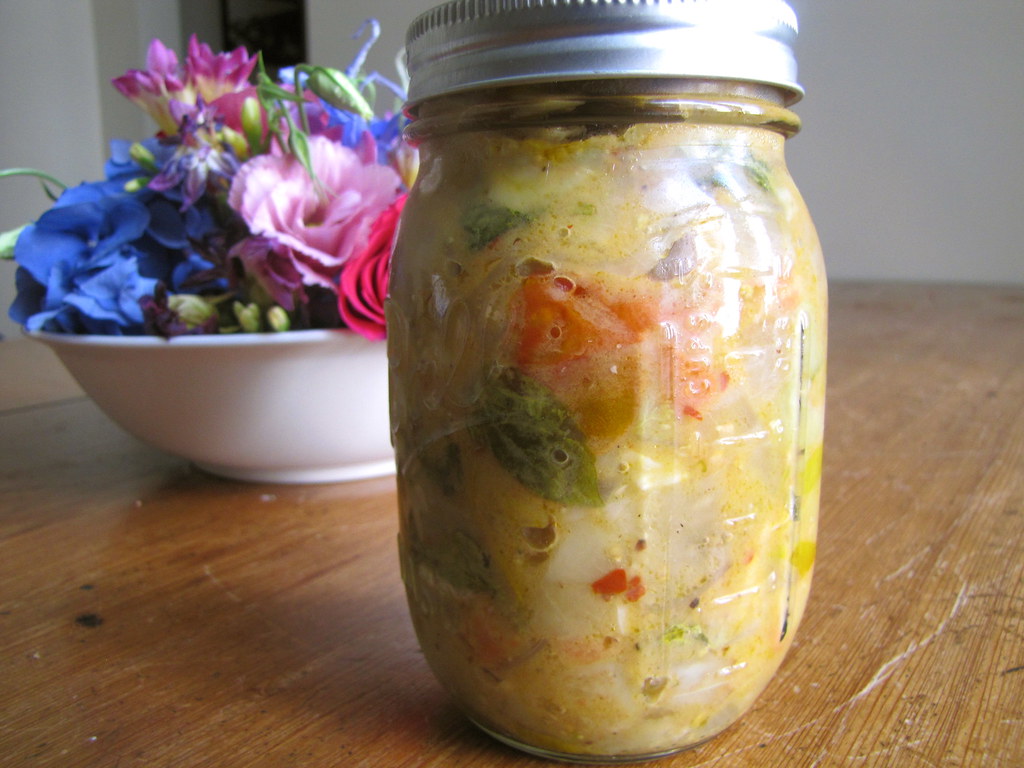
9 Responses
Eva
This sounds tasty, but FYI, there is a risk of botulism when you can low-acid foods like this in a water bath. If you really must store caponata for more than a week outside the fridge, please use a pressure canner. Even processing in boiling water is not enough to ensure that foods that are low in acid (and made with oil–good combination for bacteria) are safe. Yes, people used to do it and still do, but people also got food poisoning. Pressure canners are cheap and a lot of fun to use–please use one instead.
See here:
http://www.cdc.gov/features/homecanning/
http://nchfp.uga.edu/how/general/ensuring_safe_canned_foods.html
“Botulinum spores are very hard to destroy at boiling-water temperatures; the higher the canner temperature, the more easily they are destroyed. Therefore, all low-acid foods should be sterilized at temperatures of 240° to 250°F, attainable with pressure canners operated at 10 to 15 PSIG.”
Donna
This recipies is wonderful!! I have a ton of eggplant this year and this is my new go to canning recipie!
Phyllis Pampalone
I make my eggplant caponata with , eggplant, celery , onion , green olives , black olives, capers and I add crushed tomatoes , basil , oregano, garlic , salt and pepper and vinegar and sugar. I keep it it the refrigerator, it usually doesn’t last more than a week I have to make enough for my children . The one I have for myself is eleven days I said I don’t think it’s good my daughter says there’s nothing wrong because of the vinegar, what do you think? It taste alright I don’t want to get sick.
Jason
Sounds nice, but it is not Caponata. Caponata is a Sicilian dish with eggplant, onions, celery, olives, capers, raisins & pignoli stewed with tomato, vinegar and sugar.
kelly
That is the best way. http://browserreview.net/chrome
Francesco
I’ve been eating caponata in Siciliy, where it was invented, since around 1967. That disgusting mixture in that jar is NOT Caponata by any shape or form. Just because you have a blog with extra time to write doesn’t mean you should. Hopefully no one will eat that after making it believing they are eating Caponata.
sidd yadav
I am really proud https://www.spreaker.com/user/siddydv26
GLENN STANTON
THAT jar does NOT contain caponata. The pic got my attention because I thought it was illustrating A canning disaster!
As I read on I was horrified to think someone might actually eat what is bubbling in that jar.
Caponata? not even close !
You have made stewed eggplant with tomato. gross
ps ”SQUISHY” Is not a culinary term .
Elaine Webber
I bought several sealed jars of caponata at Mandala Farm in Italy several years ago. Maybe 2011, would it still be good. they have been stored in cool dark closet.